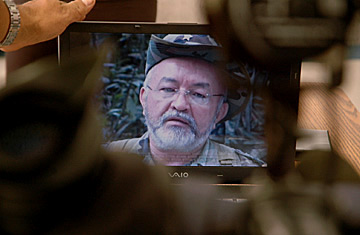
Raul Reyes, second in command of the Revolutionary Armed Forces of Colombia (FARC), is shown in a 2007 video released in Santiago, Chile. The Colombian government recently announced that Reyes was killed in a gun battle with Colombian soldiers.
Plan Colombia is one of the most brazen foreign aid sleights of hand ever perpetrated by Washington. Since its launch in 2000, the more than $5 billion crusade was meant to help violence-torn Colombia eradicate drug cultivation and trafficking — an effort that is largely regarded a failure. Instead, the billions have not-so-subtly been employed to help the Colombian military beat back the fierce Marxist guerrilla army known as the Colombian Revolutionary Armed Forces, or FARC, and the success of that mission was underscored Saturday by the stunning news from Bogota that the army, using Plan Colombia-funded communications technology, had found and killed the FARC's No. 2 leader and spokesman, Raul Reyes, in an air raid and gun battle.
Critics might still complain that Plan Colombia — which has made the South American nation the third-largest recipient of U.S. military aid outside Iraq — is ignoring its original purpose. But the Bush Administration would argue that by beheading the FARC, Plan Colombia is actually fulfilling its anti-drug mandate — because at least half of the between $500 million and $1 billion the FARC is believed to earn each year is derived from protecting Colombian cocaine trafficking. The other half is made via ransom kidnapping — the FARC currently holds more than 700 hostages in its jungle redoubts, including three Americans — which is the other reason the U.S. State Department placed the rebels on its list of international terrorist groups a decade ago (as does the European Union today).
At that time, the FARC seemed to have the upper hand against Colombia's historically feckless state and its even more dysfunctional military. Back then, Washington "was seriously considering whether the FARC might win," U.S. Ambassador to Colombia William Brownfield told TIME recently. But the Clinton and Bush II Administrations, still constrained by bitter memories of America's involvement in the Vietnam and Central American conflicts of a generation ago, couldn't stick their hands too directly into Colombia's four-decade-old civil war. What they could do, however, was cloak counter-insurgency as drug interdiction. It's a strategy backed by Colombia's conservative and widely popular President Alvaro Uribe, who since his election in 2002 has made his priority security and the resurrection of the country's armed forces in its fight against the FARC — which killed his father in 1983. (Uribe, however, is also embroiled in a scandal over his government's alleged ties to Colombia's bloodthirsty right-wing paramilitary armies, which are also narco-fueled and on State's terrorist list.)
So while the cultivation of coca, cocaine's raw material, is up again, the FARC is down — from close to 20,000 fighters in the 1990s to about half that today. A big reason is that the military in recent years has killed or arrested command figures like the bearded and glib Reyes, 59, who was one of the less mysterious FARC comandantes because of his role as media flack. His real name was Luis Edgar Devia Silva — and his satellite phone apparently gave away his location in remote southwestern Colombia, near or across the Ecuadoran border. Bogota has also begun extraditing FARC leaders to the U.S., and two of them were recently convicted and handed lengthy federal prison sentences. It's not even certain if the FARC's 77-year-old leader, Manuel Marulanda (known as Tirofijo, or Sureshot) is still alive; and morale among the rebels' rank and file is said to be crumbling.
The FARC, perhaps the last leftist guerrilla army in a hemisphere where they were once iconic, used to have international legitimacy and sympathy in its fight against Colombia's epic inequality; but that was before it became widely branded as a "narco-guerrilla" group. Perhaps panicked by its dark fortunes of late, the FARC has been trying in recent months to reverse its mafioso image by releasing some of its higher-profile hostages — but not the three U.S. defense contractors it abducted in 2003 after their plane crashed in southern Colombia. Those men — Keith Stansell, Thomas Howes and Marc Gonsalves — completed five years in FARC captivity last month. Martin Sombra, the FARC veteran who admits to having been one of the jungle jailkeepers of the three Americans, was captured by Colombian authorities last week. But his arrest is unlikely to help get the Americans released by the FARC, which is demanding the release of its members held in the U.S. as a precondition.
Reyes' death, of course, won't end the Colombian conflict. And it won't remedy the dark social ills, especially the misery of millions of neglected rural Colombians, which started the civil war in the first place. Concern about that aspect of Colombia's tragedy, in fact, has prompted the U.S. Congress to slash President Bush's 2008 military aid request for Colombia by 30% — not least of all because even Colombia's modernized military is still reportedly prone to ugly human rights abuses — and to raise social and economic aid by 70%.
As for drug interdiction, maybe Plan Colombia's billions are better spent on counter-insurgency after all, since the voracious U.S. and European appetite for snorting coke — widely regarded as the real cause of the drug crisis — shows little if any sign of abating. As Michael Reid notes in his insightful new book on Latin America, Forgotten Continent, "Plan Colombia [has] proved to be far more effective as a counter-insurgency plan than as an anti-drug plan, though it [has] been sold to the American public as the latter." The U.S. had put a $5 million bounty on Reye's head — and the Bush Administration is betting that as more headlines like his death come out of Colombia, the American public might not care all that much about being fooled.
